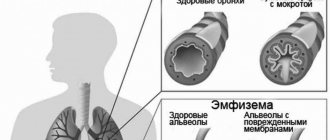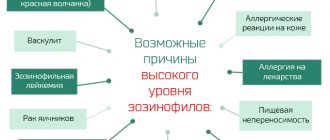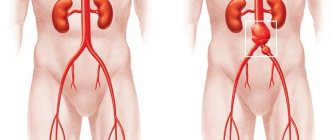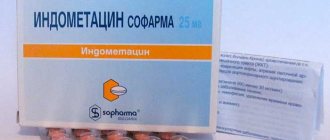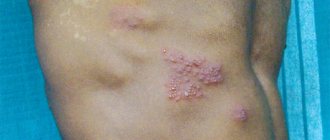Chronic heart failure is a serious pathology of the heart associated with problems with the nutrition of the organ due to insufficient blood supply during exercise or at rest. This syndrome has a whole range of typical symptoms, so its diagnosis is usually not difficult. In this case, the main mechanism of this disorder is the inability of the organ to pump blood due to damage to the heart muscle. As a result of insufficient blood circulation, not only the heart suffers, but also other organs and systems of the body that do not receive enough oxygen and nutrients.
- Causes
- Classification
- Symptoms
- Diagnostics
- Treatment
- Complications
- Prevention
Features of the disease
Heart failure is an acute or chronic condition in which the contractile manipulation of the muscles weakens and stagnant processes develop in the circulatory system.
In this case, a person with minor exertion and at rest feels shortness of breath, quickly gets tired, and suffers from blueness of the nails and the area of the nasolabial triangle.
In acute heart failure, pulmonary edema and cardiogenic shock develop. The chronic form of the disease is dangerous due to the appearance of oxygen starvation of organs and tissues. This disease is the most common cause of death in people.
A decrease in contractile functions leads to the fact that the heart cannot satisfy the body's need for blood.
Pathology worries as a result of defects, cardiomyopathy, ischemia, hypertension and other ailments.
Diagnostics
Chronic heart failure among all cardiovascular pathologies is the most common cause of hospitalization, disability and mortality of patients. Therefore, a huge role in reducing these indicators is played by timely diagnosis of the disease, which is based on instrumental examinations that allow obtaining objective data for making or confirming the diagnosis.
The main diagnostic criteria are the identification of serious changes in the heart and myocardial dysfunction.
Also, the diagnosis of CHF is carried out by conducting clinical studies (blood gas and electrolyte composition, protein levels, creatinine, carbohydrates, urea, etc.). Electrocardiography makes it possible to detect myocardial ischemia and hypertrophy, as well as any arrhythmic changes.
X-ray examination is used in the diagnosis of this pathology in order to identify congestion in the lungs, and ventriculography allows one to assess the contractility of the ventricles. Echocardiography makes it possible to determine the cause of the development of this syndrome in humans, as does MRI.
Main reasons
The development of the acute form occurs under the influence of:
- Diseases that reduce the contractility of the heart muscle, damaging or stunning it. This occurs during myocardial infarction, when disruption of blood flow to an area of the heart causes cell death, during inflammation of the heart muscle, as well as after heart surgery or as a result of the use of a heart-lung machine.
- Decompensation of chronic failure, as a result of which the heart cannot provide the organs with sufficient blood.
- Violations of the integrity of valves and chambers.
- Accumulation of fluid between the sheets of the pericardial sac, making normal contraction of the heart impossible due to compression of the cardiac cavities.
- Thickening of the walls of the heart muscle.
- Hypertensive crisis. At the same time, blood pressure indicators significantly exceed the norm.
- Pathologies of the pulmonary circulation. Acute failure can be triggered by blockage of the pulmonary artery with blood clots, which usually form in the lower extremities or pelvis, acute lung pathologies such as bronchitis or pneumonia, or an acceleration or deceleration of the heart rate.
There are also non-cardiac causes of the disease. Acute cardiovascular failure can be caused by:
- infectious processes;
- developing circulatory disorders in the brain, in which tissues are damaged and organ functions are disrupted;
- extensive surgical interventions;
- severe brain injuries;
- toxic effects on the heart muscle from drugs or alcoholic beverages;
- electropulse therapy, damage resulting from exposure to electric current on the body.
Treatment of CHF with folk remedies
Treatment of heart failure with folk remedies is possible only under the supervision of the attending physician as an addition to traditional medications. You should not prescribe treatment for yourself on your own, on the recommendation of a neighbor or a friend who has a “similar diagnosis,” and also ignore taking medications prescribed by your doctor, replacing them with folk remedies.
The following herbs are usually used to prepare folk remedies:
- Chopped blueberry shoots;
- Lily of the valley flowers;
- Foxglove leaves;
- St. John's wort herb;
- Parsley seeds;
- Dry ginseng root;
- Hawthorn flowers;
- Motherwort grass and many other plants.
It should be remembered that many of these plants are poisonous. Their incorrect use or failure to comply with the dosage can result in poisoning. Treatment with folk remedies only for symptoms of heart failure, without proper treatment of the underlying disease, will not bring the expected result and may worsen the patient’s condition.
Types and stages
There are several options for the course of the disease.
If the blood flow is stagnant, then the following development is observed:
- Right ventricular failure, in which venous blood stagnates in all organs and tissues.
- Left ventricular failure with blood stagnation in the pulmonary circulation.
- Cardiac asthma. The condition is characterized by a sudden onset of shortness of breath, which turns into suffocation.
- Pulmonary edema. In this case, intravascular fluid accumulates in the lung tissues.
For the hypokinetic type of hemodynamics, the following development is observed:
- Cardiogenic shock. At the same time, the contractility of the myocardium sharply decreases, and the flow of blood to all organs and tissues stops.
- Arrhythmic shock associated with heartbeat disturbances.
- Reflex shock. It occurs as a result of severe pain and is quickly eliminated with painkillers.
- True cardiogenic shock. The problem occurs if half of the muscles of the left ventricle are affected. Typically, this occurs in people over 60 years of age with a second heart attack and in the presence of hypertension and diabetes.
A sharp deterioration in the course of chronic heart failure may also occur. In this case, adequate blood supply to organs and tissues becomes impossible.
Signs
Since the signs of chronic heart disease are extremely varied, it is not common for the patient to take its manifestations seriously, for example, accepting mild fatigue or shortness of breath as a natural reaction to physical activity, while all existing symptoms may be a manifestation of the 1st functional class. Only with further development of the disease does the patient begin to feel discomfort and worry about his well-being. The first symptoms of chronic heart failure upon diagnosis are:
- dyspnea;
- overwork;
- increased heart rate;
- periodic pain;
- swelling;
- characteristic cough.
Chronic heart failure syndrome occurs after prolonged physical exertion. Sometimes it is noticeable in a state of complete rest. Sometimes shortness of breath can be a harbinger of an upcoming heart attack.
Fatigue and increased heart rate are natural; this is facilitated by a decrease in the performance of the heart, incorrect functioning of the vascular system, and loss of muscle tone.
The appearance of periodic pain is noted in the chest area, the left side of the body (neck, temple, arm, leg). Patients describe the pain as burning or sharp. Pain often makes it difficult to diagnose the disease.
Edema in chronic heart failure warns of blood stagnation. The occurrence of a symptom is characteristic of the stage with clinical severity. Many patients note the appearance of swelling in the afternoon, but the symptom disappears after a night's sleep. However, this does not prevent the symptom from recurring the next day.
A cough at an early stage is characterized by dryness and is a sign of a lack of fluid retention in the body. Only further development of the chronic disease leads to phlegm, sometimes the cough can be accompanied by blood clots.
Characteristic symptoms
Symptoms of acute heart failure are associated with dysfunction of the left or right ventricles.
The development of left ventricular failure is observed in pathologies that increase the load on the left side of the heart. This is possible if a person suffers from arterial hypertension, aortic disease, or has suffered a myocardial infarction.
If the left ventricle cannot perform its functions, then the pressure in the large and small vessels of the lungs increases, their permeability increases, due to which the liquid part of the blood flows through their walls. Interstitial and gradually alveolar edema develops.
The clinical picture of this condition is represented by cardiac asthma and alveolar pulmonary edema. An attack occurs if a person is exposed to physical or emotional stress. Patients usually suffer from sudden suffocation at night, which forces them to wake up.
Cardiac asthma is characterized by a feeling of shortness of breath, rapid heartbeat, cough with phlegm, severe weakness, and cold sweat. An attack forces a person to sit down and lower their legs.
Examination reveals pale skin, blue discoloration of the nasolabial triangle, and severe shortness of breath. The pulse will be weak, often full, arrhythmic, the boundaries of the heart expand to the left, the heart sound is dull. Blood pressure gradually decreases. Breathing becomes harsh, isolated dry wheezing is heard.
With the development of stagnation in the pulmonary circulation, pulmonary edema progresses. During sudden suffocation, the patient begins to cough and produces foamy pink sputum, this is due to the appearance of blood impurities in it.
The patient breathes like a boiling samovar, is in a sitting position with his legs down, his face turns blue, the neck veins swell, and the skin becomes covered with cold sweat.
Also read: What is restrictive cardiomyopathy
If pulmonary edema is present, it is necessary to urgently transport the patient to the intensive care unit and provide medical assistance, since the likelihood of death is very high.
Left atrial failure occurs with mitral stenosis. Clinical manifestations are similar to left ventricular pathology.
The development of right ventricular failure occurs due to blockage of large branches of the pulmonary artery by a thrombus.
Stagnation in the systemic circulation develops, causing the lower extremities to swell, pain on the right under the ribs, veins in the neck to burst and pulsate, shortness of breath occurs, the surface of the skin turns blue, and pressing pain appears in the heart area.
There is also a weakening of the peripheral pulse and a sharp decrease in blood pressure.
If right ventricular pathology develops in the stage of decompensation, then signs appear earlier than in acute left ventricular failure. This is due to the fact that the latter has a large set of compensatory capabilities, since it is the most powerful part of the heart.
Classification and degrees of CHF
The classification made it possible to have a unified approach to diagnosis, as well as, more importantly, treatment of this condition. The first classification dates back to 1935, its authors were Soviet cardiologists N.D.
Strazhesko and V. Kh. Vasilenko. For a long time it remained the only one, but in 1964 the NYHA (New York Heart Association) classification was adopted in New York. Cardiologists determined the functional classes of CHF on it.
It was adopted at the XII Congress of Therapists of the USSR. Classification of CHF is carried out in 3 stages:
- Stage I - initial. It is characterized by the fact that hemodynamic disorders are compensated and are detected only with significant physical activity (domestic) or stress tests - treadmill, Master's test, bicycle ergometry (during diagnosis).
Clinical manifestations: shortness of breath, palpitations, fatigue at rest disappear;
- Stage II - severe heart failure. When it occurs, hemodynamics are disrupted (stagnation of blood in the circulatory system), the ability to work is sharply impaired, tissues and organs do not receive the required amount of oxygen. Symptoms occur at rest. It is divided into 2 periods - IIA and IIB. The difference between them: at stage A there is failure of either the left or right parts of the heart, when at stage B there is total heart failure - biventricular;
Stage IIA - characterized by stagnation in the pulmonary or systemic circulation. At this stage of heart failure, in the first case, left ventricular failure occurs.
It has the following clinical manifestations: complaints of shortness of breath, cough with the release of “rusty” sputum, suffocation (usually at night) as a manifestation of the so-called cardiac asthma.
When examining, pay attention to pallor, cyanosis of the extremities, tip of the nose, lips (acrocyanosis). There is no swelling. The liver is not enlarged. On auscultation, you can hear dry rales; with severe congestion, signs of pulmonary edema (fine-bubble rales).
When cardiac function is impaired with the development of stagnation of the systemic circulation, patients complain of heaviness in the right hypochondrium, thirst, swelling, abdominal distension, and indigestion.
There is cyanosis of the face, swelling of the veins of the neck, external edema (later - cavitary edema: ascites, hydrothorax), enlarged liver, heart rhythm disturbances. Treatment at this stage may be especially effective.
Stage IIB - represents total heart failure with severe manifestations of circulatory failure. Combines symptoms of blood stasis BCC and MCC. This stage is very rarely reversible.
Stage III - final stage, heart failure in the decompensation stage. Deep myocardial degeneration occurs, irreversibly damaging both the heart itself and the organs experiencing ischemia and oxygen starvation due to its dysfunction. It is terminal and never undergoes regression.
In Russian practice it is used together with the above. In addition to dividing into stages, functional classes of chronic heart failure are distinguished based on exercise tolerance:
- FC I - the patient has no restrictions on physical activity. Habitual loads do not cause pathological symptoms (weakness, shortness of breath, pressing pain, palpitations);
- FC II - load limitation is assessed as “moderate”. There are no signs of pathology at rest, but performing normal physical activity becomes impossible due to palpitations, shortness of breath, anginal pain, and a feeling of lightheadedness;
- FC III - “pronounced” limitation of exercise, symptoms are relieved only with rest, and performing even less physical activity than usual provokes the appearance of clinical signs of the disease (weakness, angina, shortness of breath, interruptions in heart function);
- FC IV - inability to tolerate even the slightest (everyday) physical activity, that is, intolerance to it. Discomfort and pathological symptoms are caused by activities such as washing, shaving, etc. Also, signs of heart failure or pressing chest pain can occur at rest.
These two classifications relate to each other as follows:
- CHF stage I - NYHA functional class 1
- CHF stage II A - NYHA functional class 2–3
- CHF II B - Stage III - NYHA FC 4
It is not always easy to draw the line between “moderate” and “severe” limitation of activity, since subjectively the doctor and the patient may assess this differently.
For this purpose, various unifying methods are currently used, and those that require the least material costs and instrumentation are preferable.
In the USA, a modification of the Cooper test (6-minute corridor walk) is popular, in which the distance traveled is assessed. A distance of 425 - 550 meters corresponds to mild CHF; 150–425 — tension of compensatory reactions — average; less than 150 meters - decompensation - severe heart failure.
Often in Russian hospitals the cardiology department is located on the 3rd–4th floors of the building, and this is no coincidence. The data obtained in this way can be used to assess circulatory failure.
If shortness of breath occurs and the patient is forced to stop climbing when climbing 1 flight of stairs - functional class 3, to the 1st floor - 2nd, when climbing 3 floors - 1st. In patients with FC 4 - decompensated, shortness of breath can be observed even at rest.
The New York classification is especially significant when assessing changes in the condition of patients during therapy.
Assigning a patient's status to a certain stage of CHF is important for selecting therapy, assessing its results, as well as predicting disease outcomes. For example, stage I chronic heart failure certainly requires the use of fewer drugs and, conversely, stage III CHF forces the cardiologist to prescribe 4–5 groups of drugs.
Assessing the dynamics of the functional class of circulatory failure is important, again, for selecting therapy, following a diet, and prescribing a rational motor regimen.
The value of classifying the patient’s status for prognosis can be characterized by the following statistics: annually, 10% of patients die from heart failure in FC 1, approximately 20% in FC 2, about 40% in FC 3, and in FC 4, the annual mortality rate exceeds 65%.
- Chronic heart failure 1st degree. It is characterized by shortness of breath when the patient climbs stairs to the third floor or higher, while at the same time his physical activity continues to remain normal.
- 2nd degree CHF. Shortness of breath appears in a person after climbing one floor or simply when walking quickly. A decrease in physical activity becomes more noticeable, and with normal exercise, signs of the disease appear.
- 3rd degree CHF. Its symptoms begin to appear even when walking and normal exercise, but they go away in a calm state.
- Chronic heart failure stage 4. Even at rest, it retains its symptoms, and with the slightest increase in physical activity, deficiencies in the functioning of the cardiovascular system sharply appear.
By origin
- Myocardial CHF. occurs in the case of direct damage to the heart walls due to disturbances in energy metabolism in the myocardium. This type of CHF leads to systolic and diastolic disturbances in the functioning of the heart.
- Overload CHF is the result of prolonged increased cardiac load. It can occur due to heart defects or problems with blood flow.
- Combined CHF appears due to excessive load on the heart with damaged myocardium.
- Left ventricular CHF is caused by a decrease in myocardial contractile function or overload of the left ventricle. Aortic stenosis often leads to such overload, and a decrease in contractile function may be a consequence of a previous myocardial infarction. This type of CHF leads to a reduction in the release of blood into the systemic circulation and the formation of stagnation in the pulmonary circulation.
- With right ventricular CHF, blood begins to stagnate in the systemic circulation, while the release of blood into the pulmonary circulation decreases due to overload of the right ventricle. Pulmonary hypertension often leads to this condition. The dystrophic form of right ventricular CHF is the most severe and at the same time its last stage. With it, the patient’s body is depleted, the skin becomes flabby, thins, and persistent swelling appears.
- The mixed form of CHF is caused by simultaneous overload of both cardiac ventricles.
The classification of CHF may be based on various clinical signs. Depending on which parts of the heart are more involved in the pathological process, heart failure can be right ventricular or left ventricular.
There are three stages of chronic heart failure according to ICD 10:
- At the first stage, the disease manifests itself only under the influence of other provoking factors, for example, physical activity.
- At the second stage, the pathological process affects one of the blood circulation circles (small or large), according to which the leading symptoms develop.
- The third stage is characterized by irreversible morphological structural changes in target organs.
In medical practice in our country, two classifications of chronic heart failure are used. They have some differences, but mostly complement each other.
Stage 1. Patients experience virtually no symptoms indicating the development of the disease. With heavy physical exertion, they experience slight fatigue and weakness.
In rare cases, tachycardia and dizziness occur.
Stage 2. Signs of the disease begin to manifest themselves even when patients are at rest. But their intensity is very weak and lasts for a long time.
| Functional class I (FC I) | Patients with heart disease that does not limit physical activity. Normal physical activity does not cause fatigue, palpitations, or shortness of breath |
| Functional class II (FC II) | Patients with heart disease that causes slight limitation of physical activity. At rest, patients feel well. Normal exercise causes excessive fatigue, palpitations, shortness of breath, or angina |
| Functional class III (FC III) | Patients with heart disease that causes significant limitation of physical activity. At rest, patients feel well. Mild physical activity causes fatigue, palpitations, shortness of breath, or angina |
| Functional class IV (FC IV) | Patients with a heart condition that prevents them from performing even minimal physical activity. Fatigue, palpitations, shortness of breath and attacks of angina pectoris are observed at rest, with any load these symptoms intensify |
Table of contents:
- Classification of chronic heart failure - signs, degrees and functional classes
- CHF according to Vasilenko-Strazhesko (stages 1, 2, 3)
- New York (1, 2, 3, 4 FC)
- Chronic heart failure 1st degree 2nd class
- Second functional class of angina pectoris
- Causes
- Symptoms
- Diagnostics
- Treatment
- Consequences and prevention
- Features of stage 1 hypertension: its symptoms and treatment
- Stage 1 hypertension, what is it?
- Symptoms of stage 1 hypertension
- The first signs of stage 1 hypertension
- Risks 1, 2, 3 and 4
- Causes of stage 1 hypertension
- Diagnostics
- What tests are needed?
- Treatment
- Diet for stage 1 hypertension
- Drugs for stage 1 hypertension
- Complications
- Are they allowed into the army with stage 1 hypertension?
- Prevention
- What is heart failure: symptoms, signs and treatment of the disease
- Causes of the disease
- Types of heart failure
- Classification
- Signs and symptoms of the disease
- Heart failure in newborns and adolescents
- Methods for diagnosing heart failure
- Methods of treating the disease
- What is the danger of heart failure, consequences and complications?
- Disease prevention
- Heart failure: classification, diagnosis and treatment
- What is chronic heart failure?
- Why does this happen?
- What's happening?
- Diagnosis
- Treatment
- What does the abbreviation of the disease CHF 2 FC 2 stand for?
- Causes of CHF development, risk factors
- Classification of pathology and symptoms of CHF 2 degrees
- Features of the second degree of CHF
- How to treat CHF
- initial, manifested in the sick person for the first time;
- assignment of I-IV functional class to a patient with persistent symptoms of the disease;
- increasing, angina pectoris.
Diagnosis
Signs of acute heart failure are an indication for urgent hospitalization. During diagnostics:
- Analyze the medical history and evaluate the patient's complaints.
- Analyze your life history. This will allow us to identify possible causes of the development of the pathological condition.
- The presence of similar problems in close relatives is determined.
- Conduct a medical examination. Determination of wheezing in the lungs, murmurs in the heart, measurement of blood pressure, and determination of hemodynamic stability (features of blood movement through the vessels) are carried out. Maintain adequate blood pressure and heart rate levels.
- Electrocardiography is performed. The study reveals an increase in the size of the left ventricle, signs of overload and other specific features of impaired blood flow to the heart muscle.
- A general blood test is prescribed. The procedure reveals the presence of an inflammatory process by increasing the level of leukocytes and increasing the erythrocyte sedimentation rate.
- A general blood test is performed. If protein, leukocytes and red blood cells appear in the urine, this indicates diseases that are a complication of heart failure.
- A biochemical blood test is performed to determine the level of cholesterol, triglycerides, and glucose.
- Echocardiography is performed. This is an ultrasound examination of the heart, which is used to evaluate and monitor the local and general functions of the ventricles, valves, identify pathological processes in the pericardium, mechanical complications after myocardial infarction, neoplasms in the heart and other features.
- The level of biomarkers that are specific signs of myocardial damage is determined.
- A chest x-ray is ordered. During the procedure, the size and clarity of the heart shadow, as well as the severity of congestive processes in the lungs, are assessed. X-rays can confirm the diagnosis and evaluate the effectiveness of therapy.
- The gas composition of the blood is determined.
- Coronary angiography is prescribed. This is a radiopaque technique for examining the coronary vessels that supply blood to the heart. The procedure helps to identify where and how severely the artery is narrowed.
- Multislice computed tomography is performed using a contrast agent. During the examination, a contrast agent is injected, which allows you to see an image of the heart and create a three-dimensional model of it. The method is necessary to identify possible defects in the walls of the heart, valves, check their operation and identify narrowing of the blood vessels of the heart.
- Pulmonary artery catheterization is performed to determine the acute form of heart failure.
- Magnetic resonance imaging is prescribed to obtain an accurate image of the organ.
- Natriuretic peptide is determined. Its level increases depending on the degree of heart failure.
Treatment of chronic heart failure
Treatment for heart failure, like many other diseases, begins with a healthy lifestyle and healthy diet. The basis of the diet is to limit the consumption of table salt to approximately 2.5 - 3 grams per day. The volume of liquid you drink should be about 1 – 1.3 liters.
Food should be easily digestible and high in calories with sufficient vitamins. It is important to weigh yourself regularly, because... weight gain of even a couple of kilograms per day may indicate fluid retention in the body. Consequently, this condition aggravates the course of CHF.
For patients with heart failure, proper, constant physical activity is extremely important, depending on the functional class of the disease. A decrease in physical activity is necessary in the presence of any inflammatory process in the heart muscle.
The main groups of medications used for chronic heart failure:
- ACEIs (angiotensin-converting enzyme inhibitors). These drugs slow down the development and progression of CHF. They have a protective function for the kidneys, heart and blood vessels, and reduce high blood pressure.
- Drugs from the group of angiotensin receptor antagonists. These drugs, unlike ACE inhibitors, block the enzyme to a greater extent. Such drugs are prescribed if you are allergic to ACE inhibitors or if side effects occur in the form of a dry cough. Sometimes both of these medications are combined.
- Beta blockers are drugs that reduce blood pressure and heart rate. These substances have additional antiarrhythmic properties. Prescribed in conjunction with ACE inhibitors.
- Aldosterone receptor antagonist drugs are substances that have a weak diuretic effect. They retain potassium in the body and are used by patients after myocardial infarction or with severe CHF.
- Diuretics (diuretics). Used to remove excess fluid and salts from the body.
- Cardiac glycosides are medicinal substances that increase cardiac output. These herbal preparations are used mainly for the combination of heart failure and atrial fibrillation.
Additional drugs used in the treatment of heart failure:
- Statins. These medications are used to reduce the level of fats in the blood. This is necessary to minimize their deposition in the vascular wall of the body. Preference is given to such drugs for chronic heart failure caused by coronary heart disease.
- Anticoagulants of indirect action. Such drugs prevent the synthesis in the liver of special substances that promote increased thrombus formation.
Auxiliary drugs used for complicated heart failure:
- Nitrates are substances whose chemical formula is based on salts of nitric acid. Such drugs dilate blood vessels and improve blood circulation. They are used mainly for angina pectoris and cardiac ischemia.
- Calcium antagonists. Used for angina pectoris, persistent high blood pressure, pulmonary hypertension or valvular insufficiency.
- Antiarrhythmic drugs.
- Disaggregants. Along with anticoagulants, they reduce blood clotting. Used as a prophylaxis against thrombosis: heart attacks and ischemic strokes.
- Inotropic non-glycoside stimulants. Increases the force of heart contraction and blood pressure.
Electrophysiological methods of treating CHF
- Installation of a permanent pacemaker (IVR - artificial pacemaker), which sets the heart the correct rhythm.
- Implantation of a defibrillator-cardioverter. In addition to creating a constant rhythm, such a device is capable of delivering an electrical discharge when life-threatening arrhythmias occur.
Surgical treatment options
- Coronary artery and mammary coronary bypass surgery. The essence of the procedure is to create additional vessels from the aorta or internal mammary artery to the heart muscle. This surgical intervention is performed when there is severe damage to the heart’s own arteries.
- If there is significant stenosis or insufficiency of the valves, surgical correction is performed.
- If it is impossible or ineffective to use the above-described methods of therapy, a complete heart transplant is indicated.
- The use of special artificial circulatory support devices. They are something like the ventricles of the heart, which are implanted inside the body and connected to special batteries located on the patient’s belt.
- With a significant increase in the cavity of the heart chambers, in particular, with dilated cardiomyopathy, the heart is “wrapped” with an elastic frame, which, in combination with proper drug therapy, slows down the progression of CHF.
Treatment methods
Acute heart failure is a life-threatening condition.
Treatment of the disease after first aid depends on the underlying cause:
- If the disorder is caused by arrhythmia, then in order to stabilize the patient’s condition and improve blood circulation, the normal frequency of contractions is restored.
- In the presence of myocardial infarction, systemic thrombolysis is used to restore normal blood flow, that is, thrombolytic drugs are used to dissolve blood clots. Medicines are administered intravenously.
- If acute failure occurs due to injury, myocardial rupture, or valve damage, it is necessary to urgently hospitalize the patient and provide him with surgical care.
Acute congestive right ventricular failure is treated by correcting the conditions that caused it, that is, eliminating thromboembolism and status asthmaticus.
Heart failure is eliminated directly:
- Oxygen therapy.
- Sedation. Medicines induce sleep from which the patient can be awakened at any time.
- Painkillers.
- Cardiac glucosides, which have a stimulating effect on the heart.
- Cardiotonics to increase the contractility of the heart muscle.
- Diuretics to remove excess fluid from the body.
- Vasodilator drugs.
- Disaggregants to reduce platelet aggregation.
Volume overload
It develops in the process of excessive supply of the heart muscle with venous blood returning to the heart. If there are septal defects or valve defects, then the load on the heart will increase all the time and defects will develop.
If we consider the causes of chronic heart failure by gender, then in men its cause is more often coronary heart disease, and in women it is arterial hypertension. Statistics show that in Russia alone, almost 15 million people suffer from the disease, which is why it is so important today for chronic heart failure to know the symptoms and treatment.
Prevention
To avoid acute heart failure, you must:
- visit a doctor at least twice a year, especially if you have chronic diseases of the cardiovascular system;
- stop smoking and drinking alcohol;
- avoid psycho-emotional stress;
- maintain optimal body weight;
- provide yourself with regular physical activity;
- monitor blood pressure indicators;
- eat rationally and balanced, eat foods that contain more fiber, avoid fried foods, hot and spicy foods;
- control cholesterol levels.
Following these recommendations will reduce the likelihood of developing acute heart failure.
Symptoms of chronic heart failure
There are several main classic manifestations of CHF, which occur regardless of the degree of damage to other organs of the body. The severity of these symptoms depends entirely on the form of heart failure and its severity.
The main complaints of patients suffering from CHF:
- Tachycardia (increased heart rate more than 80 - 90 beats per minute).
- Shortness of breath, accompanied by increased shallow breathing.
- Increased fatigue and a noticeable decrease in exercise tolerance.
- The appearance of a dry cough, which then turns into a cough with sputum discharge. Sometimes veins of scarlet blood are visible in it.
- Swelling of the trunk. They first appear on the feet, then move up to the legs and thighs. After this, the lower back and abdominal area swell. Fluid may accumulate in the lungs.
- The appearance of orthopnea is increased shortness of breath with a horizontal position of the body. In this case, the patient’s cough also intensifies when lying down.
Chronic heart failure
New York (1, 2, 3, 4 FC)
The functional classification is based on exercise tolerance as an indicator of the severity of circulatory failure. Determining the patient's physical abilities is possible based on a thorough history taking and extremely simple tests. Based on this feature, four functional classes are distinguished:
- I FC . Everyday physical activity does not cause dizziness, shortness of breath or other signs of myocardial dysfunction. Manifestations of heart failure occur against the background of unusual or prolonged physical activity.
- II FC . Physical activity is partially limited. Everyday stress causes discomfort in the heart area or anginal pain, attacks of tachycardia, weakness, and shortness of breath. At rest, the state of health returns to normal, the patient feels comfortable.
- III FC . Significant limitation of physical activity. The patient does not experience discomfort at rest, but everyday physical activity becomes unbearable. Weakness, pain in the heart, shortness of breath, attacks of tachycardia are caused by less than usual loads.
- IV FC . Discomfort occurs with minimal physical activity. Attacks of angina or other symptoms of heart failure can occur at rest without any apparent reason.
See the table of correspondence between the classifications of CHF according to NYHA and N.D. Strazhesko:
Functional classification is convenient for assessing the dynamics of the patient's condition during treatment . Since gradations of the severity of chronic heart failure according to functional criteria and according to Vasilenko-Strazhesko are based on different criteria and do not accurately correlate with each other, when diagnosing, the stage and class according to both systems are indicated.
Here is a video about the classification of chronic heart failure:
CHF according to Vasilenko-Strazhesko (stages 1, 2, 3)
The classification was adopted in 1935 and is still used today with some clarifications and additions. Based on the clinical manifestations of the disease during CHF, three stages are distinguished:
- I. Latent circulatory failure without concomitant hemodynamic disorders. Symptoms of hypoxia appear with unusual or prolonged physical activity. Possible shortness of breath, severe fatigue, tachycardia. There are two periods A and B.
Stage Ia is a preclinical variant of the course, in which cardiac dysfunction has almost no effect on the patient’s well-being. Instrumental examination reveals an increase in ejection fraction during physical activity. At stage 1b (latent CHF), circulatory failure manifests itself during physical activity and goes away at rest. II. In one or both circles of blood circulation, stagnation is expressed that does not go away at rest. Period A (stage 2a, clinically pronounced CHF) is characterized by symptoms of blood stagnation in one of the blood circulation.
Stage 3a is treatable; with adequate complex therapy for CHF, partial restoration of the functions of the affected organs, stabilization of blood circulation and partial elimination of congestion are possible. Stage IIIb is characterized by irreversible changes in metabolism in the affected tissues, accompanied by structural and functional disorders.
The use of modern drugs and aggressive treatment methods quite often eliminates the symptoms of CHF corresponding to stage 2b to a preclinical state.
Vascular insufficiency
Vascular insufficiency is a condition characterized by a violation of general or local circulation. This circumstance is a consequence of insufficient function of blood vessels, which is caused by a decrease in their tone, impaired patency, and a decrease in the volume of blood passing through them.
Depending on how the disorders spread, systemic and regional (local) failure are distinguished. Chronic and acute vascular insufficiency are also distinguished. The difference between these two forms lies in the speed of the disease.
Pure vascular insufficiency is a fairly rare phenomenon. As a rule, vascular insufficiency occurs against the background of symptoms of heart muscle failure. Thus, cardiovascular failure occurs as a result of the influence of the same factors on both the vascular muscles and the heart muscle. In some cases, cardiovascular failure becomes secondary, and heart pathology occurs due to improper muscle nutrition (low pressure in the arteries or lack of blood).
Acute vascular insufficiency is a clinical syndrome that occurs as a result of a sharp decrease in circulating blood volume, as well as deterioration of blood supply to vital organs, which is a consequence of blood loss, a decrease in vascular tone (poisoning, infection, etc.), and impaired contractile function of the myocardium. Acute vascular insufficiency manifests itself in the form of fainting, shock or collapse.
Fainting is the most common and fairly mild form of acute vascular insufficiency, which is a consequence of short-term anemia of the brain. This form of acute vascular insufficiency manifests itself as a result of various cardiovascular diseases and blood loss. In addition, acute vascular insufficiency can also occur in a healthy person, for example, due to severe anxiety, overwork or hunger.
Causes
Among the main causes of vascular and cardiovascular insufficiency are circulatory disorders in the arteries and veins, which can occur for various reasons.
As noted above, the main reasons for the development of acute cardiovascular failure include heart disease, blood loss, as well as traumatic brain injuries and pathological conditions, such as severe infections, acute poisoning, severe burns, and organic damage to the nervous system.
Symptoms of vascular insufficiency
Among the main symptoms of vascular insufficiency in acute form are weakness, darkening of the eyes, nausea, and rapid loss of consciousness. The same symptoms, accordingly, are characteristic of fainting. Other symptoms of vascular insufficiency in acute form include low blood pressure, weak and rare pulse, pale skin, and muscle relaxation.
During collapse, a person is usually conscious, but his reactions are extremely inhibited. Symptoms of vascular insufficiency in this case include low temperature, weakness, low blood pressure and tachycardia.
The main symptom of vascular insufficiency is a sharp and rapid decrease in blood pressure, which contributes to the occurrence of other symptoms.
The main symptom of vascular insufficiency in chronic form manifests itself in the form of arterial hypertension.
Diagnosis of the disease
Diagnosis of cardiovascular failure consists of examining the patient by a doctor, during which he evaluates the general symptoms of the disease and also determines its form. It should be noted that the level of pressure is far from the decisive factor in making the final diagnosis. In order to make an accurate conclusion, the doctor studies and analyzes the patient’s medical history, and also determines the reasons that caused the attack. In order to provide appropriate assistance to the patient, it is very important to determine during the examination the type of failure: vascular or cardiac.
In case of cardiovascular failure, the patient should be in a sitting position, since in a lying position his condition worsens significantly. In case of vascular insufficiency, the patient needs to be in a supine position, since in this position the brain is better supplied with blood. In case of heart failure, the patient’s skin acquires a pinkish tint, and in case of vascular failure, it becomes grayish. Vascular insufficiency is characterized by normal venous pressure. In this case, the veins in the neck are collapsed, there is no congestion in the lungs characteristic of cardiac pathology, and there is no displacement of the border of the heart.
After the diagnosis is determined, the patient is provided with first aid, and in some cases hospitalized, and an appropriate examination of the circulatory system is prescribed. In case of vascular insufficiency, electrocardiography, vascular auscultation, venography or sphygmography may be prescribed.
Treatment of vascular insufficiency
Vascular or cardiovascular insufficiency requires immediate first aid.
In case of acute vascular insufficiency, the patient is placed in a supine position, and in case of fainting, the compressive clothing on the neck should be loosened, the victim’s face and chest should be sprinkled with water, patted on the cheeks, offered to sniff ammonia, and also provide access to fresh air.
After the patient has regained consciousness, you should immediately call an ambulance. On-site doctors conduct general diagnostic tests and administer an intravenous or subcutaneous solution of caffeine with sodium benzoate 10%. For severe bradycardia, orciprenaline sulfate 0.05% or adrenaline solution 0.1% is usually additionally administered. If the victim does not come to his senses after 2-3 minutes, the same drugs are administered intracardially, cardiac massage is performed, and artificial respiration is performed.
The patient is hospitalized if the cause of fainting remains unclear, additional resuscitation measures are required, the patient’s blood pressure remains low, or vascular insufficiency appears for the first time. In other cases, patients are usually not hospitalized.
In case of collapse, patients require mandatory hospitalization to provide emergency medical care, maintain heart activity and blood pressure. At the hospital they stop the bleeding. if there is such a need, symptomatic therapy procedures are carried out.
Cardiovascular failure is characterized by the development of cardiogenic collapse, in which tachycardia is eliminated and atrial flutter is stopped.
In order to restore and maintain pressure, mesaton 1% is used.
Caffeine, ascorbic acid. glucose, sodium chloride, cocarboxylase are administered subcutaneously if the collapse was caused by poisoning or infection. A fairly effective remedy in this case is strychnine 0.1%.
Attention!
This article is posted for educational purposes only and does not constitute scientific material or professional medical advice.
Diagnostic and therapeutic measures
For diagnosis, mainly instrumental research methods are used:
- Electrocardiogram. Allows you to identify myocardial hypertrophy, rhythm and conduction disturbances. In addition, an ECG can detect post-infarction changes.
Echocardiography. It is the main method for diagnosing the disease. Evaluates cardiac function, degree of systole and diastole disturbance, and volume of cardiac chambers.
- X-ray of the chest organs. An x-ray can reveal an enlarged heart, as well as congestion in the pulmonary vessels.
- Bicycle ergometer test. Helps determine the FC of the disease.
Additionally, laboratory tests are also used. They do not confirm the diagnosis, but are prescribed to assess the general condition of the body and identify characteristic complications. They are carried out for differential diagnosis. Based on the results of blood biochemistry, it is possible to evaluate the function of other organs that may be damaged secondary (for example, kidneys, liver).
Treatment of pathology must be comprehensive. During therapy you need to follow a diet and limit physical activity. The diet mainly consists of limiting salt intake. In addition, harmful foods should be excluded from the diet: fried, fatty, canned foods.
The following drugs are used for drug treatment:
Read also: Liver in heart failure
Beta blockers (Carvedilol, Bucindolol, Bisoprolol) block receptors of the sympathetic nervous system and reduce heart rate. This has a beneficial effect on the condition of the myocardium. Beta blockers reduce the likelihood of cardiomyocyte depletion. The drug intake is started with the lowest possible dose, then, if well tolerated, the dosage is increased.
- ACE inhibitors (Lisinopril, Captopril) are the main group of medications for CHF. The drugs prevent myocardial remodeling, which helps slow the progression of the disease.
- Diuretics (Asparkam, Furosemide) accelerate fluid excretion, stimulating diuresis. This allows you to reduce the severity of edema. Loop diuretics are mainly used.
- Nitrates. Reduce the load on the heart and the severity of clinical symptoms. Long-acting nitrates are mainly used.
- Cardiac glycosides (Digoxin) normalize the heart rate and are prescribed for a decompensated state, often in the last stages.
In addition to drug therapy, surgical methods are used. They are mainly aimed at treating the primary disease. For example, a damaged heart valve is replaced, a pacemaker is implanted, or stenting is performed. The most radical method of surgical treatment is a heart transplant.
CHF is a serious disease that often leads to the development of complications and irreversible consequences. The prognosis for this pathology is most often unfavorable; it is impossible to be completely cured. However, the outcome depends on how early the diagnosis was made and therapy prescribed.
Forecast
The syndrome and type of acute heart failure can only be diagnosed as a result of a proper medical examination. The prognosis for patients cannot be called negative. According to statistics, the mortality rate of patients within 60 days after the onset of the disease is 10%. For re-hospitalization – 35%. The first year of the disease is characterized by a mortality rate of 40%.
Almost every second patient diagnosed with the disease requires readmission to the hospital.
To save the patient, it is necessary to undergo a qualified medical examination. Based on the results of the tests, the doctor makes a diagnosis and prescribes treatment. It is not recommended to ignore the first signs of acute heart failure. The disease develops quite quickly, and sometimes it is impossible to save a person’s life.
What happens in a “tired” heart
The heart muscle needs a lot of nutrients and oxygen. The cells contain fibers of the protein actomyosin, which provide stretching and contraction of the myocardium under the influence of the reinforcing nerve. Thus, the central nervous system is involved in the regulation of heart contractions. Energy is needed to replenish and renew actomyosin. The lack of a sufficient amount of kilocalories leads to a decrease in muscle performance and the development of congestive heart failure. The contractions of the heart become slower and weaker, and it does not empty completely, as it is not able to push all the blood into the aorta and pulmonary artery.
First, a compensatory reaction is activated - thickening of the muscle. When “reinforcement” does not arrive, muscle tissue becomes flabby. Overflow of the chambers leads to a wave of stagnation “behind the heart.” Insufficiency in the left sections causes blood retention in the pulmonary circulation, in the lung tissue. With isolated insufficiency of the right sections and general muscle weakness, venous blood is retained in large veins, the liver, and throughout the systemic circulation.
All tissues receive “poor quality” blood and experience oxygen starvation. The bone marrow is stimulated and additional blood cells are produced. This puts even more strain on the heart, aggravating heart failure.
Scientists attribute a major role in the progression of the disease to the renal mechanism: renal blood flow decreases 4 times, this causes sodium retention, and with it water, which leads to venous congestion and edema.
All causes leading to impaired contractility of the heart muscle can be divided into two groups: primary and secondary. The primary ones include those that cause toxic damage when:
- acute and chronic myocarditis (rheumatism);
- poisoning with toxic substances and toxic poisons, internal products of tissue breakdown (sepsis, severe infectious diseases);
- endocrine disorders (thyrotoxicosis, diabetes mellitus);
- anemia (anemia);
- damage to the nervous system, brain injuries, stroke.
Secondary causes are understood as those that do not directly affect the heart muscle, but create mechanical conditions for fatigue and oxygen starvation. This group includes:
- hypertonic disease;
- atherosclerosis of large vessels;
- acquired and congenital heart defects;
- adhesions around the heart, compressing blood vessels.
The division may be conditional. For example, if, against the background of hypertension, a person gets sick with influenza pneumonia. You can read more about the causes of heart failure here.
Symptoms
Manifestations of CHF depend mainly on the severity and severity of the disease. Sometimes signs may be completely absent or appear minimally. The stronger the myocardial damage, the more pronounced the clinical symptoms of the disease.
The main symptoms of the disease are as follows:
Dyspnea. This symptom is the main sign of the disease, thanks to which the degree of complexity of the pathology is determined. In the initial stages of the disease, shortness of breath occurs only with increasing load, then it manifests itself even at rest.
Edema of the lower extremities. The accumulation of excess fluid always occurs in both legs at once, gradually rising from the ankles to the hips. The structure of the edema is quite dense; when pressed, marks remain.
Manifestations are most pronounced in the evening before bedtime. If the patient does not receive medical attention, more severe symptoms may occur: fluid accumulation in the abdominal cavity (ascites), chest drops, and swelling of the skin.
Limitation of physical activity. This is especially noticeable in the later stages of the disease. Decreased cardiac output leads to exercise intolerance. It becomes difficult for a person to walk long distances, climb stairs, and then make normal movements. In the terminal period, the patient can only lie in bed.
Nonspecific symptoms characteristic of the primary disease may also be observed. For example, fever, general weakness, increased fatigue.
First aid
If the above symptoms appear, you must:
• call emergency medical care, • give the patient a sitting position, • place the legs in heat (a heating pad, a container of hot water), • measure blood pressure when systolic pressure is above 100 mm Hg, give 1 tablet of nitroglycerin under the tongue or 1 inhalation under tongue, if the patient’s condition improves, repeat taking nitroglycerin after 10 minutes, then every 10 minutes until the ambulance arrives. If there is no effect, do not give nitroglycerin again, • try to calm the patient.


